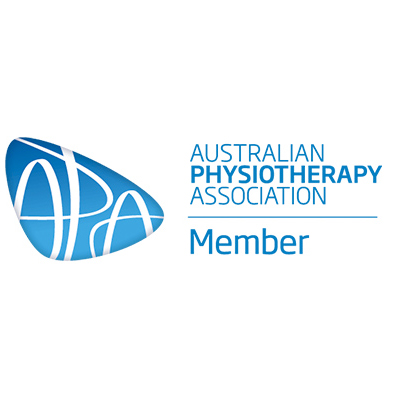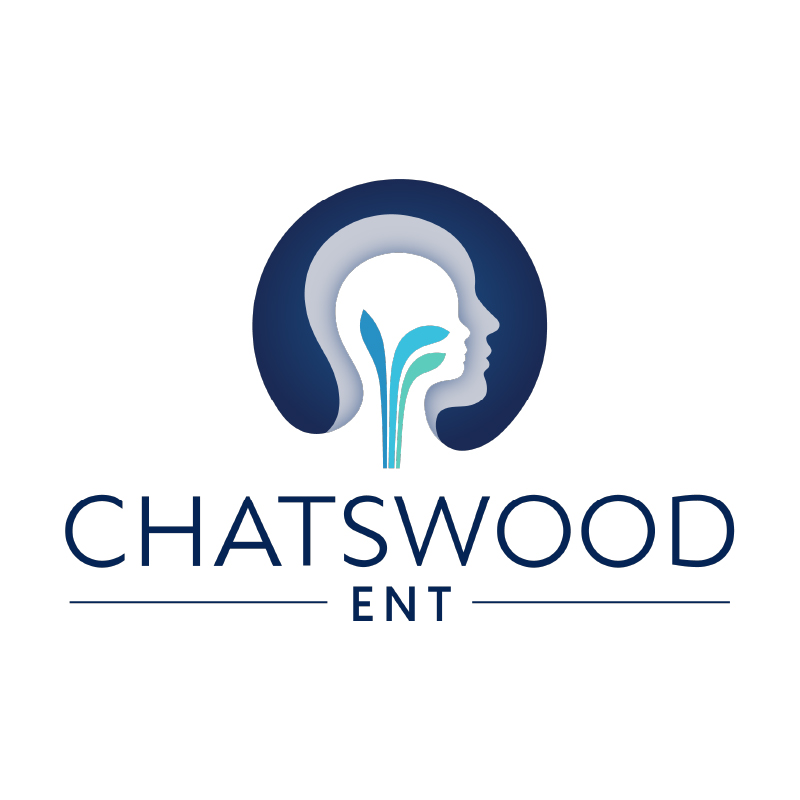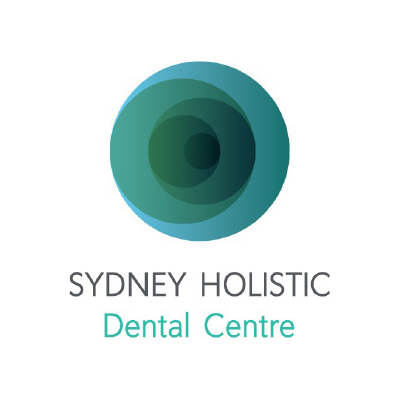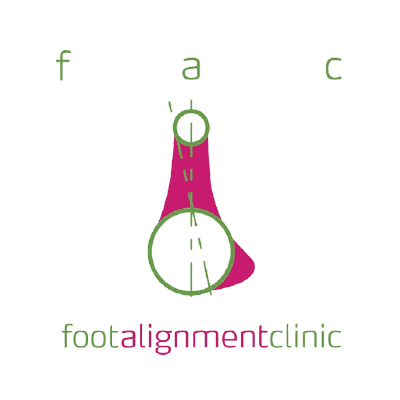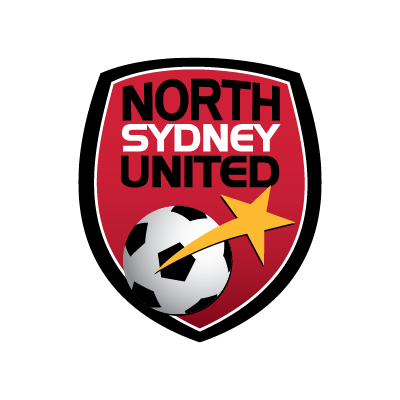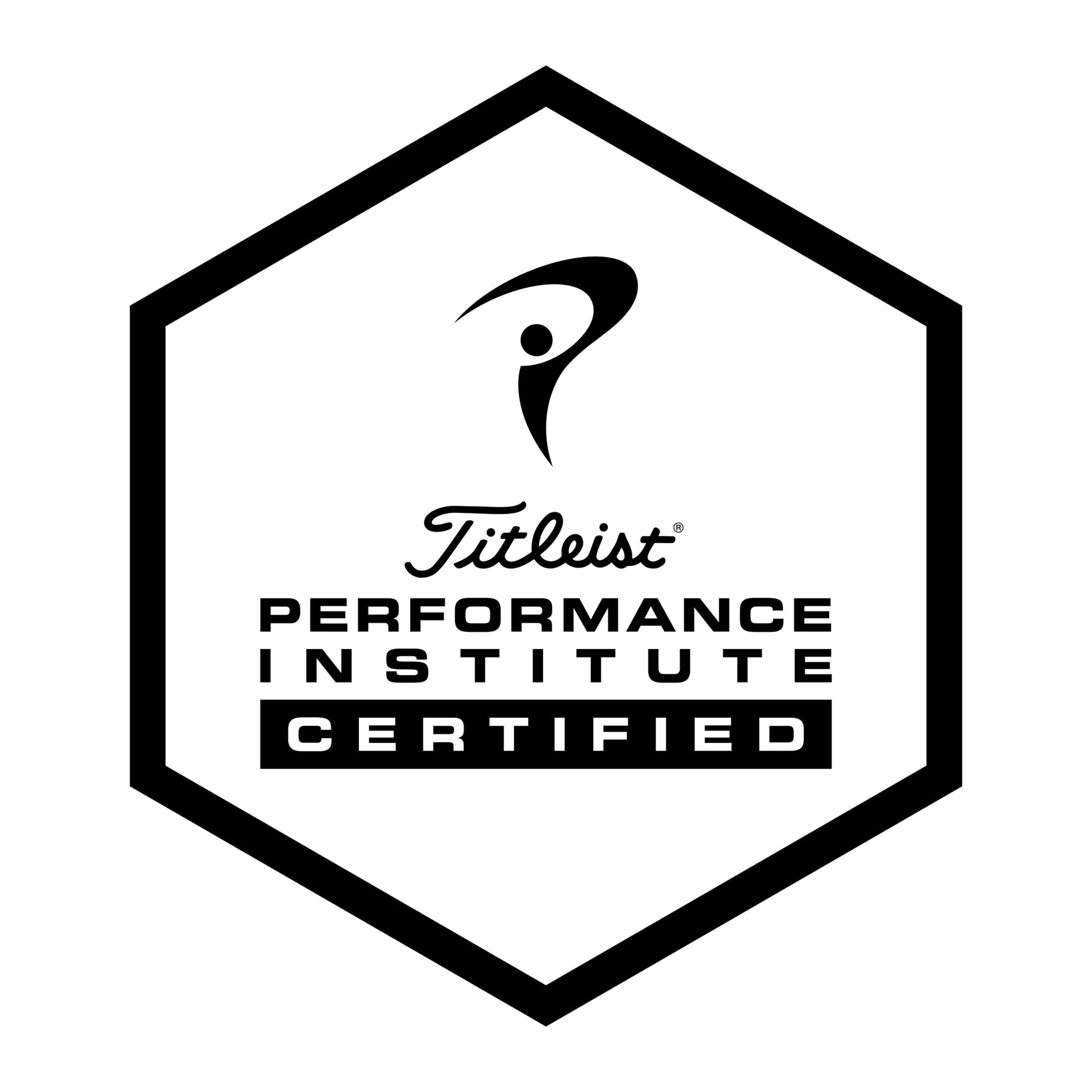Shockwave Physiotherapy Sydney
Unlock the benefits of Shockwave Therapy in Sydney
Treat pain deeper & faster
Extracorporeal shockwave therapy (ESWT) technology uses sound waves to transfer energy into dysfunctional tissues. The tissues are tendons, fascia, ligaments, muscle, and bone.
At EastWest Physiotherapy, we use a radial pressure wave device, which produces acoustic shockwaves to a depth of 5-6cm. The machine’s settings and applicator dictate the energy levels at depth. This energy input into the tissues reignites the body’s natural healing process.
The shockwaves are pro-inflammatory, which is vital in regeneration at a cellular level.
If you’re ready to explore a fast, evidence-based option for persistent pain or tendon issues, contact our team today to learn how shockwave physiotherapy in Sydney can help.
Rapid Return to Fun & Function
At EastWest Physiotherapy, we are delighted to incorporate shockwave therapy into our healing process. We follow the Release, Restore, Retrain model of physiotherapy. Shockwave is involved in the restore phase, which aims to restore mobility and function to damaged and degenerative tissues (muscle, tendon, and fascia).
Usually, after 1-3 sessions, a huge improvement in pain, power, and mobility is achieved.
Want to experience the benefits of extracorporeal shock wave therapy in a supportive clinical setting? Book your first appointment with our Sydney clinic today.
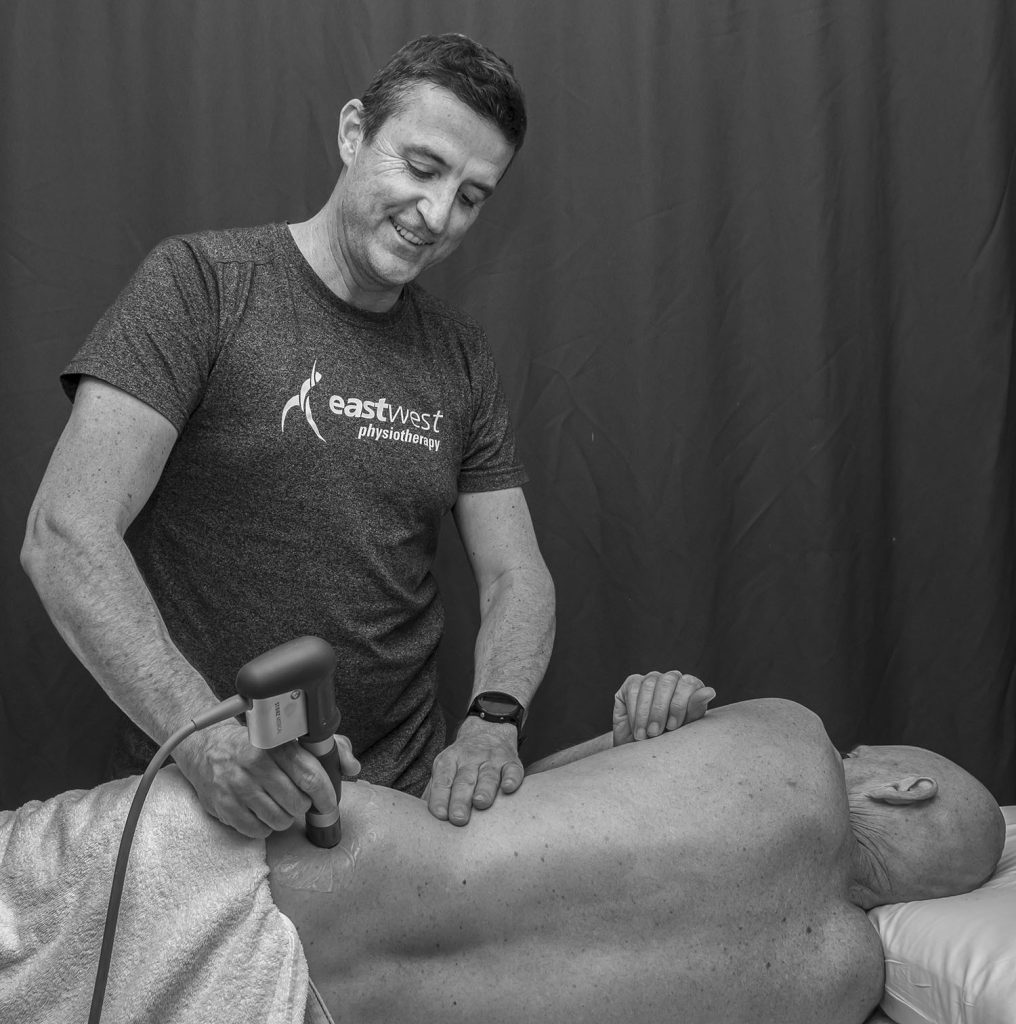
How does Shockwave Therapy work?
The normal healing process of the body occurs in four stages.
First, the body responds to injury by bleeding, which is then followed by inflammation.
Within a few hours to days, the third stage begins, known as proliferation, where new tissue is created to rebuild the injury.
Finally, after a few weeks, the remodelling stage starts, during which the injury fully heals.
The most important of all these stages of the healing cascade is inflammation. Without it, proliferation and remodelling will not take place. In chronic conditions, something has gone wrong during this stage, and the proliferation and remodelling stages stall, preventing the injury from fully healing. The injury gets stuck in a dysfunctional and inflammatory cycle.
Shock wave therapy reboots the process and recommences the healing cycle.
Contact our Sydney clinic to find out if extracorporeal shockwave therapy is right for your condition.
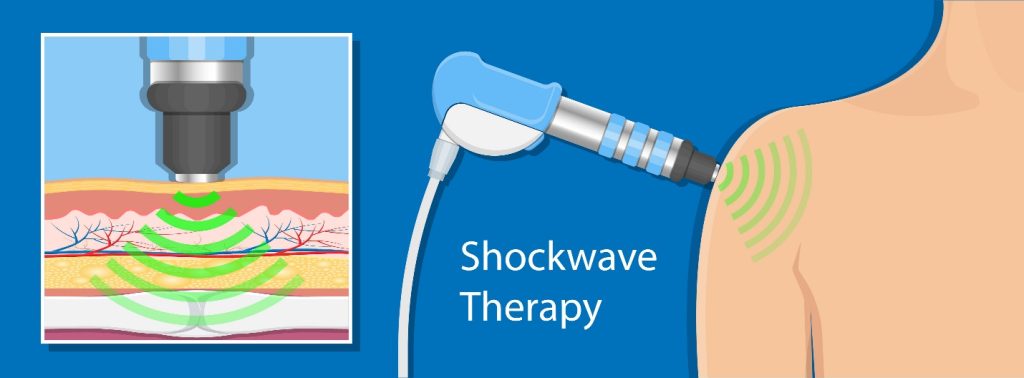
Benefits of Shockwave Therapy
Explore all the benefits provided by Shockwave Therapy.
-
Increase Blood Supply
-
Improved vascularisation & blood supply
As a result of shockwave therapy, arterioles (small blood vessels within the injured tissue) are remodelled, stimulated to grow, and new ones are formed. The new blood vessels improve blood supply and oxygenation of the treated area and support faster tendon and bone healing.
-
Disrupt Inflammation
-
Disrupting the chronic inflammation cycle means less pain
Chronic inflammation occurs when the inflammatory response is ongoing and gets stuck. It can damage healthy tissue and result in chronic pain. Mast cells are one of the key components of the inflammatory process. Their activity may be increased by using shock wave therapy.
The production of chemokines and cytokines follows mast cell activation. These pro-inflammatory compounds enhance the inflammatory process and reboot a stalled healing process.
-
Reduce Pain
-
Decrease concentration of pain-modulating chemicals
Substance P is a neurotransmitter that mediates pain information through sensory C-fibres. This neuropeptide is generally associated with intense, persistent, and chronic pain. It intensifies pain messages to the central nervous system.
Lowering the concentration of Substance P reduces pain. Decreasing Substance P, histamines, and other nociceptive metabolites also helps inhibit the development of inflammatory oedema.
-
Mobilise Fascia
-
Eliminates painful myofascial trigger points. Removes Knots
There are many approaches to treating muscle pain and trigger points. Research is suggesting shockwave therapy as one of the best treatment options, particularly for chronic muscular pain. Trigger points may cause back, neck, shoulder, and limb pain. They are associated with palpable nodules of taut bands of muscle.
The dysfunctional muscle unit contracts so tightly that it begins to cut off its blood supply. This causes waste products to build up and irritates the local sensory nerve. The assumed mechanism of action is that the delivered shockwave unblocks the calcium pump, reversing the metabolic crisis in the muscle fibre and releasing the trigger points.
-
Breakdown Calcification
-
Removal of calcification in tendons
Calcium build-up is most often a result of micro-tears or other trauma to a tendon. It is seen on plain X-ray or ultrasound. Calcification contributes to tendon pain and weakness. Shock waves break up the existing calcifications. The lymphatic system then removes the granular particles of calcium.
-
Resolve Trigger Points
-
Release bound-up fascia and improve mobility
Have you tried rolling, dry needling, deep massage, and still have areas of your myofascial system that just won’t let go? If so, give Shockwave a try. Shockwaves are used medically to break up kidney stones and are reasonably new in physiotherapy, but it is attracting global attention and has great scientific validity.
Improved vascularisation & blood supply
As a result of shockwave therapy, arterioles (small blood vessels within the injured tissue) are remodelled, stimulated to grow, and new ones are formed. The new blood vessels improve blood supply and oxygenation of the treated area and support faster tendon and bone healing.
Disrupting the chronic inflammation cycle means less pain
Chronic inflammation occurs when the inflammatory response is ongoing and gets stuck. It can damage healthy tissue and result in chronic pain. Mast cells are one of the key components of the inflammatory process. Their activity may be increased by using shock wave therapy.
The production of chemokines and cytokines follows mast cell activation. These pro-inflammatory compounds enhance the inflammatory process and reboot a stalled healing process.
Decrease concentration of pain-modulating chemicals
Substance P is a neurotransmitter that mediates pain information through sensory C-fibres. This neuropeptide is generally associated with intense, persistent, and chronic pain. It intensifies pain messages to the central nervous system.
Lowering the concentration of Substance P reduces pain. Decreasing Substance P, histamines, and other nociceptive metabolites also helps inhibit the development of inflammatory oedema.
Eliminates painful myofascial trigger points. Removes Knots
There are many approaches to treating muscle pain and trigger points. Research is suggesting shockwave therapy as one of the best treatment options, particularly for chronic muscular pain. Trigger points may cause back, neck, shoulder, and limb pain. They are associated with palpable nodules of taut bands of muscle.
The dysfunctional muscle unit contracts so tightly that it begins to cut off its blood supply. This causes waste products to build up and irritates the local sensory nerve. The assumed mechanism of action is that the delivered shockwave unblocks the calcium pump, reversing the metabolic crisis in the muscle fibre and releasing the trigger points.
Removal of calcification in tendons
Calcium build-up is most often a result of micro-tears or other trauma to a tendon. It is seen on plain X-ray or ultrasound. Calcification contributes to tendon pain and weakness. Shock waves break up the existing calcifications. The lymphatic system then removes the granular particles of calcium.
Release bound-up fascia and improve mobility
Have you tried rolling, dry needling, deep massage, and still have areas of your myofascial system that just won’t let go? If so, give Shockwave a try. Shockwaves are used medically to break up kidney stones and are reasonably new in physiotherapy, but it is attracting global attention and has great scientific validity.
Treatment Protocol
Evaluation of condition
There is no single treatment for each condition we encounter.
At EastWest Physiotherapy, we will evaluate the area that is giving you problems. We will make sure your pain is not coming from a nerve and do our best to diagnose the cause of your pain. With this, we can give you a time frame for recovery.
Shockwaves are some contraindications or precautions that will be discussed prior to starting treatment. Real-time ultrasound may be used to pinpoint the area that needs treating.
Shockwave therapy
Practitioners at EastWest physiotherapy are skilled in myofascial manipulation. The principal Physiotherapist, Gavin Johnston, is a certified Structural Integrator. He has studied the myofascial relationships within the layers of muscle, bone and nerve and how they perform the complex output of postural control. Given this strong manual therapy background, we will use the Shockwave much like any other application.
We will find the cause of your problem and then deliver the recommended dose of shockwaves to that area. This may involve different applicators targeting different tissues within the same treatment (e.g. treating the tendon first and then the muscle attached to it).
The shockwave output can be adjusted for individual sensitivities, such as pressure and pain.
Aftercare & tissue load tolerance
After receiving Shockwave, it is advised to rest for 48 hours. This will give the area time to reboot.
After this time, it is highly recommended that you proceed with a loading program specifically targeted to your phase of healing. Your therapist will explain what he/she wants you to do and email you an exercise plan.
Soaking in an Epsom salt bath can be a great adjunct to shockwave therapy, as can cold laser, acupuncture, and heat packs.
Free Shockwave & Cold Laser Advice
Conditions Treated
Explore all the conditions that can be treated by Shockwave Therapy.
-
Golfers Elbow / Medial Epicondylitis
-
Symptoms:
- Pain on the inner side of the forearm (the wrist and elbow)
- Weakness in the wrists
- Stiffness of the wrists
- Tenderness in the inner elbow.
Causes:
- Overload by repeated forceful wrist and finger movements that lead to microtrauma to the muscles and tendons
- Weightlifting
- Javelin throwing/jet skiing/windsurfing
- Swing a golf club or racket
- Squeeze or pitch a ball
- Shake hands
- Turn a doorknob
- Pick up something with your palm down
- Flex your wrist toward your forearm.
Palpation, nerve and muscle tests, Real-Time Ultrasound, and a Handheld Dynamometer can be used to evaluate. All standard care is available at EastWest Physiotherapy.
-
Tennis Elbow/ Lateral Epicondylitis
-
Symptoms include pain and weakness in the outer forearm with movements like:
- Lifting an object/racquet
- Writing or holding a cup
- Turning the wrist while opening the car door or opening a jar
- Pain or stiffness when you stretch your hand.
Causes:
Tendons become irritated when there is a sudden increase in load caused by doing something outside the tendon capacity. A major cause is the overuse of the forearm, be it in a sport or one’s profession. Micro tears occur in the tendon, which lead to inflammation and pain.
Activities such as:
- Sports such as tennis, badminton, squash or throwing a discus
- Using a paintbrush while painting the walls
- Carpentry activities
- Typing and writing
- Wear and tear due to age.
Evaluation can be done by palpation, nerve and muscle tests, Real-Time Ultrasound, and Handheld Dynamometer. All standard care is provided at EastWest Physio.
-
Shoulder Pain
-
The shoulder is the fourth most common site of musculoskeletal pain that patients report to general practitioners and physiotherapists. Rotator cuff, impingement syndrome, and rotator cuff tendinosis are terms used synonymously with shoulder pain.
There are many possible causes of shoulder pain. The following list outlines some of the common presentations to physio. When you are assessed at EastWest Physio, we need to diagnose why you are in pain.
- Tendonitis (including calcific tendonitis)
- Bursitis
- Arthritis
- Instability/dislocation
- Impingement
- Tendon tears
- Neuropathy
- Referred pain from the neck or thoracic spine
- Medical Red flags (tumour, etc).
Your therapist will examine your shoulder and determine if shockwave therapy is appropriate for your condition. If the diagnosis is unclear, we may require further medical investigation or scans. Shockwave therapy is usually an adjunct to a strengthening and mobility program, which will be prescribed depending on your diagnosis and time frame.
The current research on shockwave therapy for the shoulder concludes conflicting evidence. Some good studies have reported beneficial effects in cases of calcareous tendinopathy. We recommend using Shockwave as an adjunct to regular physiotherapy, particularly in chronic conditions.
-
Neck & Back Pain
-
Chronic muscle pain syndrome is one of the leading causes of musculoskeletal pathologies requiring treatment. Many terms have been used in the past to describe painful muscular syndromes affecting the skeletal muscles of the spine:
- Muscle hardening
- Myalgia
- Muscular rheumatism
- Fibrositis
- Myofascial Pain
- Trigger Points
Pain that persists over six months or more often becomes therapy resistant and frequently results in chronic generalised pain (Myofascial Pain Syndrome). MPS is a series of sensory, motor, and autonomic symptoms caused by muscle stiffness, hyperirritable nodules in musculoskeletal fibres, known as myofascial trigger points (MTP), and fascial constrictions.
There is good evidence suggesting that Shockwave is a good treatment for persistent muscular pain conditions. Shockwaves affect the joints in the spine (facet joints). Applying Shockwave directly over the dysfunctional joint can be more effective than injections.
At EastWest Physiotherapy, you will be examined to determine whether your back pain is likely to improve with shockwave therapy. Adjunct therapies may include exercise prescription, manual therapy, acupuncture, etc.
-
Gluteal Tendinopathy
-
Tendinopathy of the Gluteus Medius and Gluteus Minimus tendons is a primary local source of lateral hip pain. The condition mostly occurs in mid-life, both in athletes and subjects who do not regularly exercise. Females are afflicted more than males.
Symptoms occur after everyday weight-bearing tasks such as walking, climbing stairs, sleeping on the side, and sitting in low chairs. The combination of excessive compression and high tensile loads within tendons is thought to be most damaging. Diagnosis is based on gait assessment, muscle strength and compression tests.
Management of this condition commonly involves corticosteroid injection, exercise, or shock wave therapy, with surgery reserved for recalcitrant cases. The current evidence base suggests Shockwaves as an excellent adjunct to an exercise /tissue loading program.
It is important to understand why you may have lateral hip pain, as some common home remedies, such as foam rolling, may be aggravating.
-
Trochanteric Bursitis
-
Greater Trochanteric Pain Syndrome (GTPS) is a clinical condition characterised by pain and tenderness at or around the greater trochanter, which can radiate to the lateral aspect of the hip or thigh. GTPS has been attributed to trochanteric bursitis, but more recent studies suggest that this condition involves degeneration and/or tearing of the gluteal tendons.
MRI is useful for demonstrating the pathology in and around the greater trochanter or gluteal tendon and excluding other causes of lateral hip pain.
Management of this condition depends on diagnosing the severity of the tissue degeneration.
Typically, bursitis is managed with steroid injections and rest. A more progressive, evidence-based approach involves stimulating tissue repair with Shockwaves and implementing an appropriate tissue loading program—standard care at EastWest Physio.
-
Hamstring Tendinopathy
-
Patients/athletes who complain of deep buttock pain, pain when sitting, or deep, posterior, upper thigh pain may suffer from high hamstring tendon injury.
Chronic high hamstring tendinopathy is increasingly recognised as a cause of posterior hip pain in both sitting and activity-related situations. Unlike an acute tear, chronic tendinopathy usually develops gradually and may be aggravated by repetitive activities, such as running or biking, or worsened by prolonged sitting.
Hamstring tendon pain can become chronic when a damaged tendon fails to heal properly. It usually begins with one or more of the following conditions:
- A previous tear of the tendon (an acute injury) that failed to heal correctly.
- Chronic tendinitis is an inflammatory tendon condition that can lead to non-inflammatory, degenerative changes to the structure or composition of the tendon (called tendinosis or chronic tendinopathy).
Hamstring tendinopathy can potentially cause significant pain and long-term disability. This pain and disability may be avoided by recognising symptoms, seeking an accurate diagnosis and getting treatment.
Shockwave therapy is a safe and effective treatment for patients with chronic proximal hamstring tendinopathy. As with all tendinopathy cases, an appropriate loading program is highly recommended and will be prescribed with shockwave therapy.
-
Achillies Tendon Pain
-
The Achilles tendon is the band of tissue that runs down the back of the lower leg, connecting the calf muscle to the heel bone. It is also called the heel cord.
Achilles tendonitis and tendonosis are usually caused by a sudden increase in repetitive activity involving the Achilles tendon. Common examples are running and jumping activities, which can put too much stress on the tendon too quickly, leading to micro-injury of the tendon fibres.
Due to ongoing load stress on the tendon, the body cannot repair the injured tissue. The tendon’s structure is then altered, resulting in continued pain.
The gold standard for tendon treatment is a loading program specific to the phase of healing of the tendon. Clinical trials have shown that a combination of shockwaves and exercise is significantly more effective in treating pain and improving function.
-
Plantar Fascia Pain
-
The plantar fascia is a piece of strong, thick tissue that runs along the bottom of the foot. It connects the heel bone to the toes, creating the foot’s main arch. Syndromes of pain in the plantar fascia have been called plantar fasciitis; however, because there is usually no inflammation, plantar fasciosis is more correct. Plantar fasciosis may involve acute or chronic stretching, tearing, and degeneration of the fascia at its attachment site.
Plantar fasciosis can be caused by:
- Playing sports that put stress on the foot, like running and hiking.
- Pronated/flat-footed or high arches
- Being overweight (high BMI)
- Pregnancy
- Spending a lot of time on your feet
- Wearing shoes with poor arch support or stiff soles
- Mortons foot.
The main symptom of plantar fasciitis/fasciosis is pain under the heel, which can be dull or sharp. The medial arch may ache or burn, and your heel may be slightly swollen.
The pain is often worse:
- In the morning, as you take your first steps
- After prolonged standing or sitting
- After intense activity.
Treatment should include a combination of the following :
- Specific loading and mobility exercises
- Strapping
- Cold laser/acupuncture
- Shoes with good support and cushioning
- Moderate reduction in activity
- Custom orthotics.
If these measures don’t work and you have had the pain for over three months, Shockwave therapy is highly recommended, and clinical trials have shown it to be very effective.
-
Muscular Pain
-
Chronic muscle pain is one of the main causes of musculoskeletal pathologies requiring treatment. Many terms have been used to describe painful muscular syndromes affecting the skeletal muscles of the spine:
- Muscle hardening
- Myalgia
- Muscular rheumatism
- Fibrositis
- Myofascial pain
- Trigger points.
Pain of this nature, if it persists over six months or more, often becomes therapy resistant and frequently results in chronic generalised pain. We will term this as Myofascial pain syndrome. Myofascial pain syndrome (MPS) is defined as a series of sensory, motor, and autonomic symptoms caused by a stiffness of the muscle, caused by hyperirritable nodules in musculoskeletal fibres, known as myofascial trigger points (MTP), and fascial constrictions.
There is good evidence suggesting that Shockwave is a good treatment for persistent muscular pain conditions. At EastWest physio, you will be examined to diagnose if your pain will likely improve with shockwave. Adjunct therapies may include exercise prescription, manual therapy, acupuncture, etc.
-
Trigger Point Therapy
-
A Trigger point is a hyperirritable spot, a palpable nodule in the taut bands of the skeletal muscles’ fascia. Direct compression or muscle contraction can elicit jump signs, local tenderness, local twitch responses, and referred pain, which usually results in a pain pattern distant from the spot.
It is sometimes difficult to determine if pain is coming from compressed nerves at the spinal level (commonly diagnosed) or local muscular issues. Often referred pain patterns are from trigger points. At EastWest Physio, you will be examined to ascertain the likely cause of your pain.
If the pain is from muscle, shockwave therapy will likely be a very effective treatment. Other treatments used as an adjunct may include Myofascial release, acupuncture, and exercise. There is good evidence suggesting that Shockwave therapy is a good treatment for persistent muscular pain conditions.
-
Arthritis
-
Arthritis is a broad and complex topic with many types, subtypes, and variations. It is an acute or chronic joint inflammation that often co-exists with pain and structural damage. Arthritis describes symptoms that include pain, stiffness, and joint deformities subsequent to an inflammatory process. Physiotherapy and Arthritis care typically involve hands-on treatment (manual therapy and mobilisation) and low-impact exercises. Shockwaves are relatively new in this sphere, but there is evidence of having positive outcomes with knee osteo arthritis.
Symptoms:
- Pain on the inner side of the forearm (the wrist and elbow)
- Weakness in the wrists
- Stiffness of the wrists
- Tenderness in the inner elbow.
Causes:
- Overload by repeated forceful wrist and finger movements that lead to microtrauma to the muscles and tendons
- Weightlifting
- Javelin throwing/jet skiing/windsurfing
- Swing a golf club or racket
- Squeeze or pitch a ball
- Shake hands
- Turn a doorknob
- Pick up something with your palm down
- Flex your wrist toward your forearm.
Palpation, nerve and muscle tests, Real-Time Ultrasound, and a Handheld Dynamometer can be used to evaluate. All standard care is available at EastWest Physiotherapy.
Symptoms include pain and weakness in the outer forearm with movements like:
- Lifting an object/racquet
- Writing or holding a cup
- Turning the wrist while opening the car door or opening a jar
- Pain or stiffness when you stretch your hand.
Causes:
Tendons become irritated when there is a sudden increase in load caused by doing something outside the tendon capacity. A major cause is the overuse of the forearm, be it in a sport or one’s profession. Micro tears occur in the tendon, which lead to inflammation and pain.
Activities such as:
- Sports such as tennis, badminton, squash or throwing a discus
- Using a paintbrush while painting the walls
- Carpentry activities
- Typing and writing
- Wear and tear due to age.
Evaluation can be done by palpation, nerve and muscle tests, Real-Time Ultrasound, and Handheld Dynamometer. All standard care is provided at EastWest Physio.
The shoulder is the fourth most common site of musculoskeletal pain that patients report to general practitioners and physiotherapists. Rotator cuff, impingement syndrome, and rotator cuff tendinosis are terms used synonymously with shoulder pain.
There are many possible causes of shoulder pain. The following list outlines some of the common presentations to physio. When you are assessed at EastWest Physio, we need to diagnose why you are in pain.
- Tendonitis (including calcific tendonitis)
- Bursitis
- Arthritis
- Instability/dislocation
- Impingement
- Tendon tears
- Neuropathy
- Referred pain from the neck or thoracic spine
- Medical Red flags (tumour, etc).
Your therapist will examine your shoulder and determine if shockwave therapy is appropriate for your condition. If the diagnosis is unclear, we may require further medical investigation or scans. Shockwave therapy is usually an adjunct to a strengthening and mobility program, which will be prescribed depending on your diagnosis and time frame.
The current research on shockwave therapy for the shoulder concludes conflicting evidence. Some good studies have reported beneficial effects in cases of calcareous tendinopathy. We recommend using Shockwave as an adjunct to regular physiotherapy, particularly in chronic conditions.
Chronic muscle pain syndrome is one of the leading causes of musculoskeletal pathologies requiring treatment. Many terms have been used in the past to describe painful muscular syndromes affecting the skeletal muscles of the spine:
- Muscle hardening
- Myalgia
- Muscular rheumatism
- Fibrositis
- Myofascial Pain
- Trigger Points
Pain that persists over six months or more often becomes therapy resistant and frequently results in chronic generalised pain (Myofascial Pain Syndrome). MPS is a series of sensory, motor, and autonomic symptoms caused by muscle stiffness, hyperirritable nodules in musculoskeletal fibres, known as myofascial trigger points (MTP), and fascial constrictions.
There is good evidence suggesting that Shockwave is a good treatment for persistent muscular pain conditions. Shockwaves affect the joints in the spine (facet joints). Applying Shockwave directly over the dysfunctional joint can be more effective than injections.
At EastWest Physiotherapy, you will be examined to determine whether your back pain is likely to improve with shockwave therapy. Adjunct therapies may include exercise prescription, manual therapy, acupuncture, etc.
Tendinopathy of the Gluteus Medius and Gluteus Minimus tendons is a primary local source of lateral hip pain. The condition mostly occurs in mid-life, both in athletes and subjects who do not regularly exercise. Females are afflicted more than males.
Symptoms occur after everyday weight-bearing tasks such as walking, climbing stairs, sleeping on the side, and sitting in low chairs. The combination of excessive compression and high tensile loads within tendons is thought to be most damaging. Diagnosis is based on gait assessment, muscle strength and compression tests.
Management of this condition commonly involves corticosteroid injection, exercise, or shock wave therapy, with surgery reserved for recalcitrant cases. The current evidence base suggests Shockwaves as an excellent adjunct to an exercise /tissue loading program.
It is important to understand why you may have lateral hip pain, as some common home remedies, such as foam rolling, may be aggravating.
Greater Trochanteric Pain Syndrome (GTPS) is a clinical condition characterised by pain and tenderness at or around the greater trochanter, which can radiate to the lateral aspect of the hip or thigh. GTPS has been attributed to trochanteric bursitis, but more recent studies suggest that this condition involves degeneration and/or tearing of the gluteal tendons.
MRI is useful for demonstrating the pathology in and around the greater trochanter or gluteal tendon and excluding other causes of lateral hip pain.
Management of this condition depends on diagnosing the severity of the tissue degeneration.
Typically, bursitis is managed with steroid injections and rest. A more progressive, evidence-based approach involves stimulating tissue repair with Shockwaves and implementing an appropriate tissue loading program—standard care at EastWest Physio.
Patients/athletes who complain of deep buttock pain, pain when sitting, or deep, posterior, upper thigh pain may suffer from high hamstring tendon injury.
Chronic high hamstring tendinopathy is increasingly recognised as a cause of posterior hip pain in both sitting and activity-related situations. Unlike an acute tear, chronic tendinopathy usually develops gradually and may be aggravated by repetitive activities, such as running or biking, or worsened by prolonged sitting.
Hamstring tendon pain can become chronic when a damaged tendon fails to heal properly. It usually begins with one or more of the following conditions:
- A previous tear of the tendon (an acute injury) that failed to heal correctly.
- Chronic tendinitis is an inflammatory tendon condition that can lead to non-inflammatory, degenerative changes to the structure or composition of the tendon (called tendinosis or chronic tendinopathy).
Hamstring tendinopathy can potentially cause significant pain and long-term disability. This pain and disability may be avoided by recognising symptoms, seeking an accurate diagnosis and getting treatment.
Shockwave therapy is a safe and effective treatment for patients with chronic proximal hamstring tendinopathy. As with all tendinopathy cases, an appropriate loading program is highly recommended and will be prescribed with shockwave therapy.
The Achilles tendon is the band of tissue that runs down the back of the lower leg, connecting the calf muscle to the heel bone. It is also called the heel cord.
Achilles tendonitis and tendonosis are usually caused by a sudden increase in repetitive activity involving the Achilles tendon. Common examples are running and jumping activities, which can put too much stress on the tendon too quickly, leading to micro-injury of the tendon fibres.
Due to ongoing load stress on the tendon, the body cannot repair the injured tissue. The tendon’s structure is then altered, resulting in continued pain.
The gold standard for tendon treatment is a loading program specific to the phase of healing of the tendon. Clinical trials have shown that a combination of shockwaves and exercise is significantly more effective in treating pain and improving function.
The plantar fascia is a piece of strong, thick tissue that runs along the bottom of the foot. It connects the heel bone to the toes, creating the foot’s main arch. Syndromes of pain in the plantar fascia have been called plantar fasciitis; however, because there is usually no inflammation, plantar fasciosis is more correct. Plantar fasciosis may involve acute or chronic stretching, tearing, and degeneration of the fascia at its attachment site.
Plantar fasciosis can be caused by:
- Playing sports that put stress on the foot, like running and hiking.
- Pronated/flat-footed or high arches
- Being overweight (high BMI)
- Pregnancy
- Spending a lot of time on your feet
- Wearing shoes with poor arch support or stiff soles
- Mortons foot.
The main symptom of plantar fasciitis/fasciosis is pain under the heel, which can be dull or sharp. The medial arch may ache or burn, and your heel may be slightly swollen.
The pain is often worse:
- In the morning, as you take your first steps
- After prolonged standing or sitting
- After intense activity.
Treatment should include a combination of the following :
- Specific loading and mobility exercises
- Strapping
- Cold laser/acupuncture
- Shoes with good support and cushioning
- Moderate reduction in activity
- Custom orthotics.
If these measures don’t work and you have had the pain for over three months, Shockwave therapy is highly recommended, and clinical trials have shown it to be very effective.
Chronic muscle pain is one of the main causes of musculoskeletal pathologies requiring treatment. Many terms have been used to describe painful muscular syndromes affecting the skeletal muscles of the spine:
- Muscle hardening
- Myalgia
- Muscular rheumatism
- Fibrositis
- Myofascial pain
- Trigger points.
Pain of this nature, if it persists over six months or more, often becomes therapy resistant and frequently results in chronic generalised pain. We will term this as Myofascial pain syndrome. Myofascial pain syndrome (MPS) is defined as a series of sensory, motor, and autonomic symptoms caused by a stiffness of the muscle, caused by hyperirritable nodules in musculoskeletal fibres, known as myofascial trigger points (MTP), and fascial constrictions.
There is good evidence suggesting that Shockwave is a good treatment for persistent muscular pain conditions. At EastWest physio, you will be examined to diagnose if your pain will likely improve with shockwave. Adjunct therapies may include exercise prescription, manual therapy, acupuncture, etc.
A Trigger point is a hyperirritable spot, a palpable nodule in the taut bands of the skeletal muscles’ fascia. Direct compression or muscle contraction can elicit jump signs, local tenderness, local twitch responses, and referred pain, which usually results in a pain pattern distant from the spot.
It is sometimes difficult to determine if pain is coming from compressed nerves at the spinal level (commonly diagnosed) or local muscular issues. Often referred pain patterns are from trigger points. At EastWest Physio, you will be examined to ascertain the likely cause of your pain.
If the pain is from muscle, shockwave therapy will likely be a very effective treatment. Other treatments used as an adjunct may include Myofascial release, acupuncture, and exercise. There is good evidence suggesting that Shockwave therapy is a good treatment for persistent muscular pain conditions.
Arthritis is a broad and complex topic with many types, subtypes, and variations. It is an acute or chronic joint inflammation that often co-exists with pain and structural damage. Arthritis describes symptoms that include pain, stiffness, and joint deformities subsequent to an inflammatory process. Physiotherapy and Arthritis care typically involve hands-on treatment (manual therapy and mobilisation) and low-impact exercises. Shockwaves are relatively new in this sphere, but there is evidence of having positive outcomes with knee osteo arthritis.
FAQs
Many patients describe shockwave therapy as mildly uncomfortable rather than painful. The sensation feels like rapid tapping or pulsing on the skin. At EastWest Physiotherapy, we tailor the intensity to suit your comfort level, and the treatment can be adjusted during the session if needed. Any post-treatment discomfort is usually short-lived and similar to mild muscle soreness.
The cost of shockwave therapy varies depending on the number of sessions required and whether it’s combined with other physical therapy treatments. We offer transparent pricing and will outline your expected costs during your initial assessment. Contact us to discuss your shockwave therapy treatment plan and pricing.
Shockwave therapy may be covered if it’s part of a physiotherapy consultation and your policy includes extras cover for physiotherapy. We recommend checking with your health fund directly. If unsure, our team can help you understand how your private health insurance applies to shockwave physiotherapy in Sydney.
Cold Laser
Cold Laser Therapy is the non-invasive application of low power laser beams to enhance cellular functions. When Cold laser therapy is placed over injured, inflamed or aged cells, photon energy is absorbed by the mitochondria (the cell’s battery). This improves tissue repair (skin wounds, muscle, tendon, bone, nerves), reduces inflammation and pain.
The benefits of Cold Laser:
Boosts oxygen levels
Inflamed or injured cells demand more oxygen to get healthy again. Applying cold laser therapy over blood vessels has been shown to release more oxygen to damaged tissues like a hyperbaric chamber effect.
Relieves inflammation
When muscles and ligaments are inured, inflammatory chemicals cause swelling and pain. Cold laser therapy drives your body’s drainage lymphatic system to move inflammation out and back into circulation.
Speeds the healing response
Cold laser therapy reduces the formation of scar tissue and adhesions during the healing phase. This means stronger repair tissue, a faster recovery and the prevention of a re-injury.
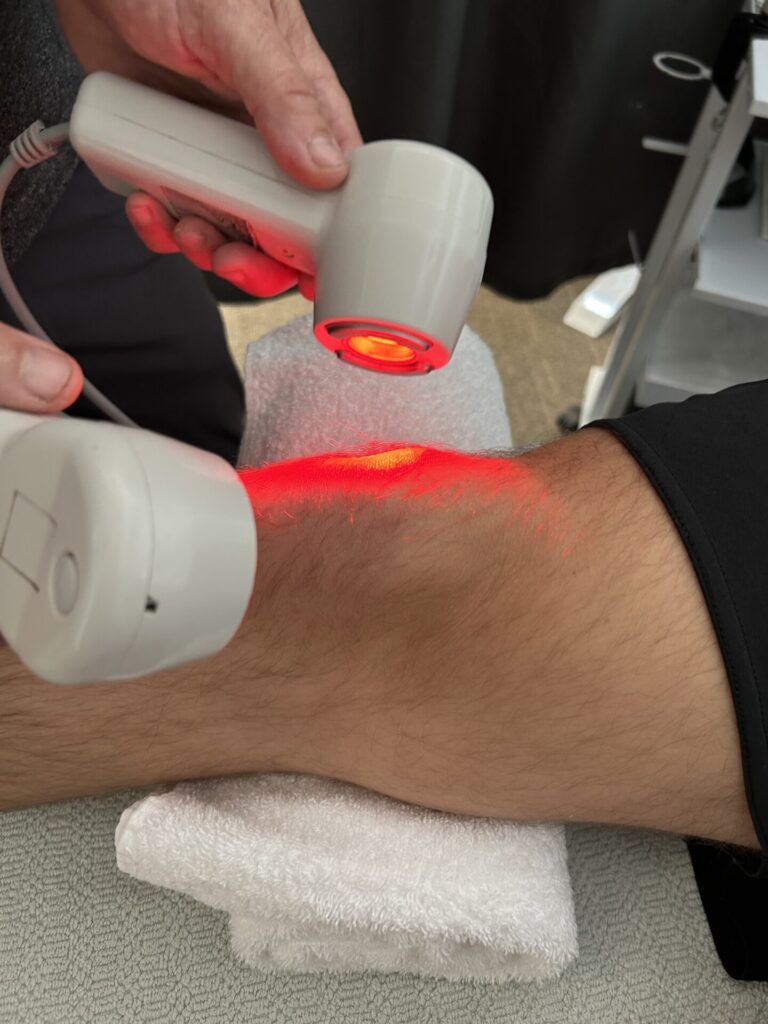
Make an appointment
If you think Shockwave Therapy could assist you, make an appointment by calling 02 9817 1781, or book online using the button below.
Got a question? Please don’t hesitate to get in touch with our friendly team.
